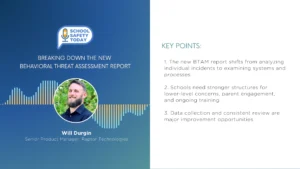A Strong Online Learning Infrastructure is Key to Higher Ed’s Future
As a growing list of colleges and universities reverse course from their previous plans and opt for a fully-remote, online learning approach instead, the risk that many will approach the transition focused more on mere survival than success is growing every day.
Granted, no institution should be expected to assemble a comprehensive online learning infrastructure overnight. Most of the schools that began investing in online education before COVID-19 envisioned it as at least a five- to 10-year project. The pioneers in online learning have been innovating for decades and still have not perfected every aspect of it. However, there are some initial steps in the right direction that schools can take as they work to design and refine their online learning infrastructure.
Related content: Why online learning is here to stay
First among these is to prioritize consistency. Students and instructors alike need a consistent user experience, whether they’re learning or teaching online. It might seem like an obvious suggestion in an age where engineering marvels like smartphones and streaming services have trained most of us to expect seamless, intuitive experiences from our technology. But it’s an area where many institutions struggle to make the leap from the siloed, department-by-department approach of yesteryear.
Building consistency into the online learning infrastructure and design yields many benefits. Students spend less time trying to figure out the differences in each course or program they’re taking, which means more time focused on learning. It also means easier support and troubleshooting for faculty in designing and maintaining courses—something that will be especially important for the countless instructors who’ll be teaching online for the first time this fall. Finally, it provides a baseline to measure courses against each other and assess metrics like student outcomes and faculty performance. When design differences can be ruled out as a confounding factor from the outset, it makes comparing and contrasting other details that much easier.
Skeptics of online learning sometimes charge that this emphasis on consistency means sacrificing creativity or unique experiences for students. Nothing could be further from the truth. In fact, just as in the on-campus setting, students’ experiences hinge more than anything else on the skill and dedication of the faculty members leading the course—not the delivery method of the instruction. Faculty who are adept at actively involving students in the learning process both with the instructor directly and with their fellow students are key here—more on that in a bit.
Schools will also need to devote time and energy to designing curriculums specifically for the online environment. Some will now have students spread across a half dozen time zones—they will require flexible options for accessing course sessions whenever they are able. Traditional colleges and universities can no longer take for granted the student-to-student interaction and engagement that campuses create either. Administrators and instructors alike must provide resources and encouragement that motivate students to take an interest in each other’s participation and progress.
Finally, effectively delivering instruction online requires paying much more attention to the science of learning itself. This means committing to continually studying and improving every aspect of how students learn online, from faculty training, to real-time feedback for students, to size and scope of content.
As just one example, schools like mine emphasize providing students with highly career-relevant skills, which means routinely connecting with employers and career experts to refine and optimize our instruction. We have industry advisory councils made up of working professionals who inform our curriculum development and help us keep it career relevant. It also means hiring faculty who are selected for their years of professional experience, and who can help students relate their learning to real-world experiences they may face in their careers. This isn’t the ideal approach for every institution, but it’s an example of how important it is to continuously assess and retool an institution’s instruction and delivery in response to changing circumstances.
We should not expect every traditional school to turn into an online education powerhouse overnight. But they should still strive to learn and improve their online learning infrastructure during this period, rather than just survive it. Despite the challenges involved, there are many insights we might gain from this great national experiment, including the long-term value of greater societal access to online learning. If we pass on the opportunity to make the most of this unexpected transition, we’ll ultimately be doing students, and the future of higher education, a major disservice.








